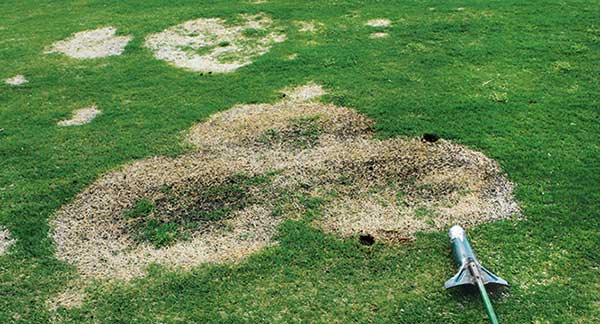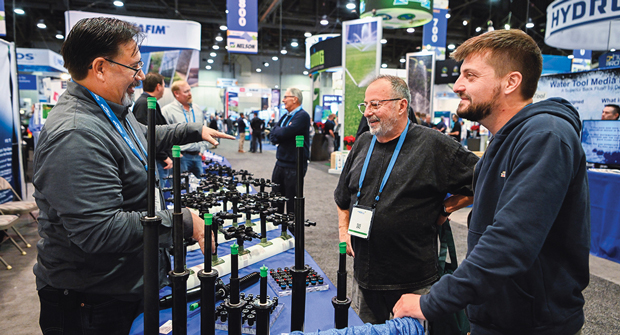Experts’ Insights: Start off spring on track

While spring dead spot symptoms show up after green-up, key control happens in the fall. (Photo: Nathan Walker)
It’s almost spring again, and many superintendents across the country will start to see signs once again of the annual foe: spring dead spot. Nathan Walker, professor of turfgrass IPM and turfgrass pathology at Oklahoma State University, offers some tips to help turf recover and provides recommendations on what to do in the fall.
First, Walker says, take photographs. This will help superintendents remember precisely where spring dead spot-prone areas are so they can treat them with appropriate fungicides in the fall.
Second, spring dead spot areas will be prone to weeds. It’s important to choose herbicides that won’t slow down turfgrass recovery. Also understand that anything done to help turf recover, whether that’s fertilizing or watering, can also help those enterprising weeds take hold.
“If they didn’t have a preventive herbicide application down, they can get weed encroachment in those dead spots because there is nothing there to compete with the weeds,” he says.
In the fall, it’s critical to get fungicides into the root zone quickly. The first application should begin as soon as root zone soil temperatures hit the mid- to lower 70s for a few days. Apply fungicides in high volumes of carrier water, 2 or more gallons per 1,000 square feet. He says it might be a good idea to have someone apply the fungicides and have another crew member quickly water them in to help get them into the root zone. He recommends making a second application about four weeks after the first.
“I recommend they (apply fungicides) early in the morning when there is a heavy dew present because that takes advantage of even more water,” he says. “You want the fungicide watered in as quickly as possible. When you’re trying to target a soil-borne disease, you’ve got to get the fungicide into the root zone. You really don’t want that fungicide bound up to the leaf surface. You want to get it into the soil so that those roots can take it up.”

Ken Hutto (Photo: FMC Specialty Solutions)
FMC Specialty Solutions
Ken Hutto, Ph.D.
Product development manager, herbicides/fungicides
In spring, management practices to encourage lateral bermudagrass growth from surrounding areas are important. Certain preemergence herbicides can inhibit rooting of bermudagrass stolons in dead areas, therefore slowing down the recovery of infected areas. Cultural practices like core aerification, sand topdressing and verticutting will encourage root growth and minimize thatch buildup. Properly time preventive fungicide applications in fall. Applying a preventive fungicide too early in fall or not applying sufficient irrigation after application may lead to less effective control. The pathogens associated with spring dead spot are soil-borne pathogens that colonize bermudagrass when soil temperatures are below 70 degrees F. There are three main Ophiosphaerella species associated with spring dead spot. Research has reported these species can respond differently to certain fertility programs.

Brian Aynardi (Photo: PBI Gordon)
PBI-Gordon Corp.
Brian Aynardi, Ph.D.
Northeast research scientist
Know where the problematic areas are on your golf course and make preventive applications for control with isofetamid. Best results are observed with two applications at rates greater than 1.0 fluid ounce of product per 1,000 square feet per application. The first application should be timed when soil temperatures at the 2-inch depth are 70-72 degrees F for three to five consecutive days, with the sequential application at the same rate occurring 21-28 days thereafter. You are not going to overwater a fungicide through the root zone because nearly all fungicides used for control of the pathogen(s) do not move down through the soil more than a few inches. Make sure to initiate post-application irrigation immediately following the application. Irrigation amounts in excess of 1/8 inch are desirable.

Ian Rodriguez (Photo: Quali-Pro)
Quali-Pro
Ian Rodriguez, Ph.D.
Technical services manager
If you have spring dead spot this spring, be sure to take notes on where it was most severe if you don’t have that already mapped. This will allow for more targeted use of fungicides next fall rather than blanketing larger areas. During the peak bermudagrass growing months, any practices that help promote a more vigorous root system and overall turf health going into the fall can help mitigate severity next year and speed up recovery. Balanced fertility, core aeration, thatch reduction and good soil moisture management can make a real difference.

Rob Golembiewski (Photo: Bayer)
Bayer
Rob Golembiewski, Ph.D.
Green Solutions Team member
Spring dead spot (SDS) is a root disease of bermudagrass that is most problematic in the Transition Zone where bermudagrass experiences winter dormancy and greater potential for freezing injury. SDS is a perennial disease with symptoms reoccurring in the same location every year if left untreated. Cultural management practices include improving drainage for optimal root growth and reducing thatch through vertical mowing and aerification. Fungicides are needed to maximize control. Initiate applications for SDS in the fall when the average soil temperature at a 2-inch depth falls below 75 degrees F. Make a second application 28 days later. Fungicides should be lightly watered in (0.25 inch) to move the product off the leaf tissue down into the plant crown and upper root zone.











